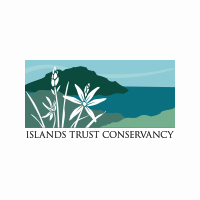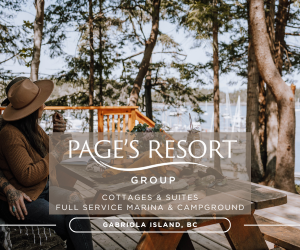Rachelle Stein-Wotten
Local Journalism Initiative Reporter, Gabriola Sounder
A kilometre off Gabriola Island’s shore are what look like a couple clothing irons bobbing up and down with the waves – or at least that’s what they remind Vicky Scott of.
They’re marbled murrelets, a threatened seabird on Canada’s Pacific coast, and Scott, a birder, has been seeing pairs fishing off Orlebar Point and flying over the island for the past seven years, but recently more often. A bird-watching group led by Scott for Gabriola Land and Trails Trust in early March also had a chance to see the rare birds, which were first designated as threatened in Canada in 1990 and confirmed in 2000 and 2012.
“It’s thrilling, they’re such amazing birds in their hardiness,” Scott said.
Fellow islander Carol McDougall has also sighted the birds starting last June and twice again off of Drumbeg Park as well as several off Valdez and Trial islands, and has posted photos to the citizen science-recording website iNaturalist.
About 28 per cent of the global population of marbled murrelet is found in Canada, around 99,100, according to the most recent recovery strategy for the species published by Environment and Climate Change Canada. Estimates for the East Vancouver Island conservation region of its habitat, in which Gabriola is located, is between 1,000-2,000 and radar counts show a population decline from 2003 to 2011 in the region. Loss of nesting habitat and forest fragmentation are considered high threats as is increased predation risk along forest edges.
Marbled murrelets usually nest on land within 30 km of the sea, so could they be nesting on Gabriola? The BC Species and Ecosystems Explorer does not record any known nest sights on the island, but the nests can be difficult to find, typically located on large, mossy limbs in the canopy of coniferous trees 30 metres and taller as well as on mossy cliff ledges and occasionally on the ground or in old deciduous trees. Marbled murrelets lay a single egg directly into mossy substrate.
Islands Trust Conservancy’s species at risk biologists have also sighted marbled murrelets offshore and flying over Gabriola, according to Erica Wheeler, species at risk program coordinator for ITC. The federal marbled murrelet recovery team has identified an area 75.05 hectares in size on Gabriola as critical habitat for marbled murrelet. It runs through parts of ITC-managed Elder Cedar (S’ul-hween X’pey) Nature Reserve, a privately owned parcel to the south of the reserve, two non-contiguous areas of habitat south of that on provincial land and the western edge of the private parcels to the east of the reserve, according to ITC.
Maps from the recovery strategy show no other terrestrial critical habitat in the Islands Trust Area for the bird.
While ITC’s 2021 management plan for the nature reserve indicates the presence of suitable trees to support nest-platforms, currently no work is underway related to marbled murrelets, Wheeler said, but with the federally funded species at risk program, now in its fourth year, that could change.
“We’ve been mostly spending the last couple years where there is clear evidence of species at risk on the lands that the conservancy manages,” Wheeler said. “If it is a case that there are more and more sightings happening locally, I think that would be something we would consider if we could play a role,” with work guided by the recovery strategy under the Species at Risk Act.
Achieving recovery goals for the marbled murrelet, which the recovery strategy describes as the decline of population and nesting habitat to have halted by 2032 and stabilized above 70 per cent of 2002 levels, requires conserving suitable nesting habitat as well as marine habitat to support all life stages of the birds.
Nesting season for seabirds as well as shorebirds is well underway, and while spotting a marbled murrelet nest on Gabriola remains elusive, Scott wants to remind people to keep a distance from any birds so they may brood and care for their young peacefully. And for anyone keen to view marbled murrelets from Gabriola, Scott recommends a good pair of binoculars or telescope, and to look between the waves when the sea is rough.





Recent Comments